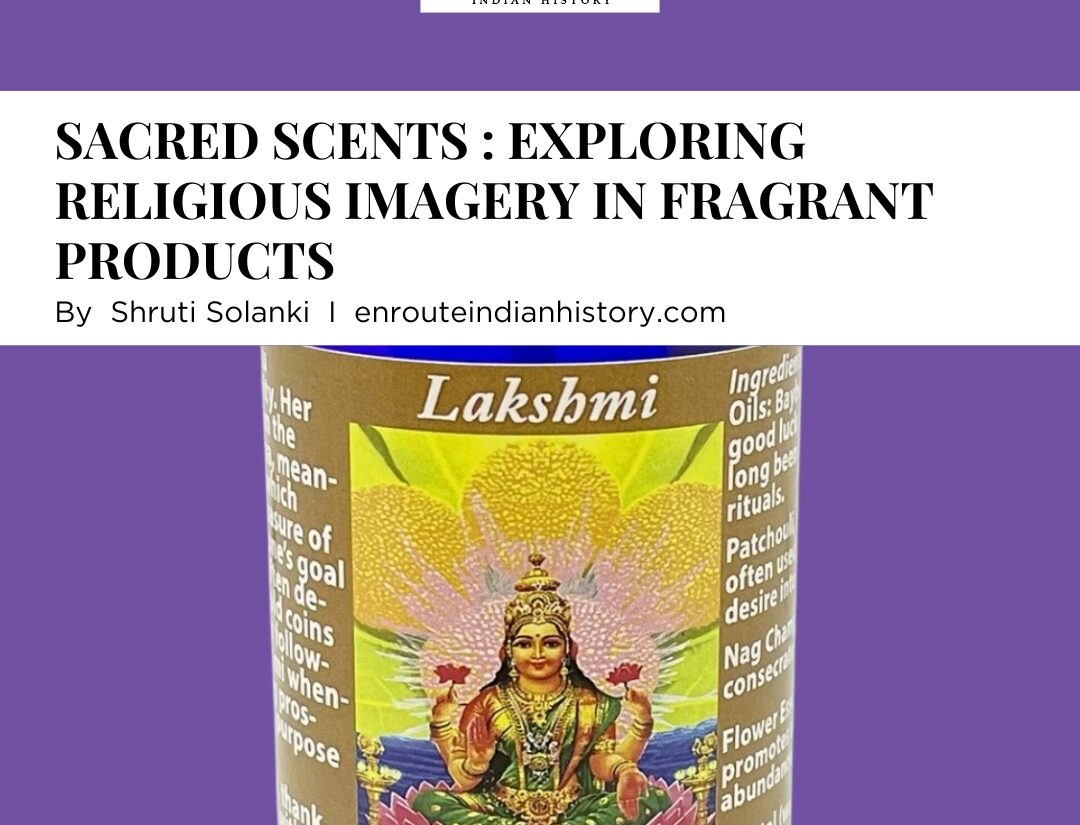Sacred Scents : Exploring Religious Imagery in Fragrant Products
- EIH User
- July 26, 2024

If one glances at perfumery (Sacred Scents)in South Asian culture and particularly in Indian History, one may effortlessly observe how certain aromatic materials are associated with worship and adornments of divinity across religions. The materialization of this association is visible in the phenomenon of using religious imagery of gods and goddesses on the packaging and advertising of fragrant products, especially the ones traditionally associated with worshiping such as incense. This commercialization of divine imagery has also made its way into the packaging of other scented products, as is evident through the usage of religious themes in soap packaging and essential oils to enhance their spiritual significance.
Sacred Scents
In contrast to the present generation where scents are merely assumed to mark an olfactory episodic memory, James McHugh noted that Indian history perceived fragrances not only for their odor but also for their visual, tactile, and other sensible qualities. Thus the sense of smell was intrinsically associated with concrete, multisensory matter, thereby extending its significance into the religious and spiritual world. We find that formulas for making perfumes and incenses are quite common in texts that provide instructions for the performance of pūjā offerings including the Āgamas and Purāṇas.
Sacred Scents – Incense and Religious Imagery
The modern era of the incense industry in India began in the 19th century, with Tanjore in Tamil Nadu emerging as a center for agarbatti (incense stick) production. This development was driven by the needs of local temples and kings. Today, India stands as one of the largest producers of agarbatti. Retrospectively, the use of incense and perfumes in India dates back to the Vedic period, where these aromatic products were integral to religious rituals and daily life. Sacred scents crafted from natural ingredients like sandalwood, camphor, and various herbs underscored their spiritual significance.

( image source – incenza.in )
The modern Incense industry captured this advantage of religious symbolism in a very efficient way. Research indicates that the presence of religious signs in advertisements fosters positive attitudes toward the ad and the brand. The intertwining of sacred scents with religious imagery in the marketing of incense and perfumed products thus leveraged deep-seated beliefs and traditions to resonate with consumers.
Consumer Culture and Fragrant Products
In contemporary India, the use of divine imagery in packaging continues to thrive, blending traditional elements with modern marketing strategies, and highlighting the enduring appeal of religious symbolism in consumer culture. Leveraging of religious icons has been found to have a higher positive impact on brand evaluation and purchase intention, a few contemporary examples may include – Hem Incense, a leading manufacturer of incense sticks, which utilizes a variety of divine images on their packaging to appeal the spiritual significance. Established in 1983, Hem’s products often feature deities like Surya or Chandrama, which resonate with consumers’ spiritual practices.

( image source – etsy.in )
Similarly, Mangaldeep incense sticks are often packaged in boxes adorned with religious imagery from Hindu mythology. These images are designed to invoke a sense of devotion and reverence among users, conditioning the consumers to associate the product with purity and spiritual efficacy.
Besides incense, Religious Symbolism in Fragrance Products is also harnessed in items such as aromatic oils, attar / itra, camphor, candles, etc packaging. For example, the following photos showcase the effort to associate Spiritual Fragrances and Product Design with Hindu divinity, making the connection between the scents and their spiritual significance compelling.


( image source – etsy.in)
Symbolic interactionism theory confirms that religious signs can elicit strong, affective responses because individuals feel an emotional attachment to things considered sacred by society. Therefore, images of gods and goddesses are incorporated into product designs, enhancing the perceived purity and effectiveness of the products. Fragrances and smells are deeply associated with religious imagery, as specific scents like sandalwood, jasmine, and camphor are traditionally used in rituals and prayers. By incorporating divine imagery, manufacturers create the multi-sensory experience which was always intertwined in Indian history reinforcing the cultural and spiritual significance of the perfumed products and appealing to consumers’ desire for a deeper connection to their faith.
References –
McHugh, J., 2011. Seeing scents: methodological reflections on the intersensory perception of aromatics in South Asian religions. *History of Religions*, 51(2), pp.156-177. The University of Chicago Press. Available at: http://www.jstor.org/stable/10.1086/660930
Agarwala, R., Mishra, P., & Singh, R., 2021. Evaluating the impact of religious icons and symbols on consumer’s brand evaluation: Context of Hindu religion. Journal of Advertising, [online] Available at: https://doi.org/10.1080/00913367.2021.1940394
Penchala Prasad, G., Pratap, G.P., Neelima, M., & Satyanrayanashastry, V.P., 2008. Historical perspective on the usage of perfumes and scented articles in ancient Indian literatures. *Ancient Science of Life*, 28(2), pp.33-39. Available at : https://www.researchgate.net/publication/224898547_Historical_perspective_on_the_usage_of_perfumes_and_scented_Articles_in_ancient_Indian_literatures
Hazarika, P., Dutta, N.B., Biswas, S.C., Dutta, R.C., & Jayaraj, R.S.C., 2018. Status of agarbatti industry in India with special reference to Northeast. *International Journal of Advanced Research in Biological Sciences*, 5(1), pp.173-186. [online] Available at: http://dx.doi.org/10.22192/ijarbs.2018.05.01.024
- Consumer Culture and Fragrant Products
- Essential Oils and Spiritual Significance
- Incense and Religious Imagery
- Packaging and Spiritual Symbols in Perfumery
- Religious Imagery in Incense Products
- Religious Symbolism in Fragrance Products
- Religious Themes in Soap Packaging
- Sacred Scents in Perfumery
- Spiritual Fragrances and Product Design
- Symbolic Scents in Essential Oils

















